How To Recognize Horse Colors - Page 2
Horse colors on this page: Paint through sorrel.
Paint
A "Paint" horse is not a color of horse. Instead, it is a horse registered with the American Paint Horse Association (APHA). Horses registered with the APHA, however, do have color (as well as bloodline and conformation) requirements, and Paint horses are characterized by their colorful, spotted coat patterns. The spots are large, and are a combination of white and any other color or colors.
While the term "Paint" horse technically means a horse registered with the APHA, the term is used more casually than that by many horse people to simply refer to a spotted horse with a stock-horse type build.
A Paint horse.
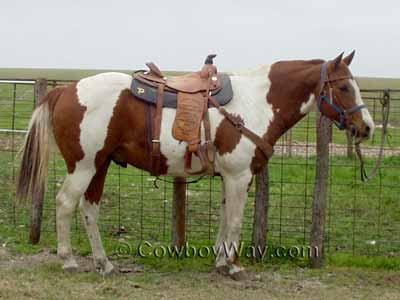
Palomino
Palominos have a body color that varies from a light tan or yellow to darker and/or more golden shades. They have manes and tails that are flaxen (lighter) or white, sometimes with a little black mixed in.
Because the palomino body color can vary dramatically, some horse people refer to the different shades as "yellow," "chocolate palomino," or "golden palomino" to denote the differences. However, they are all palominos.
A Palomino.
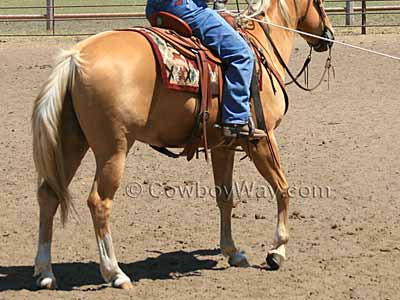
A different Palomino horse than the one shown above. This one has a slightly different golden tone, and black in its tail.

A Famous Palomino - Perhaps the most famous palomino horse in the world was a horse named Trigger. He belonged to the cowboy singer/actor Roy Rogers, and together they became one of the most beloved and famous duos in entertainment history.
Piebald
A piebald colored horse is colored with black-and-white spots. The spots are large and irregular in shape. The mane and tail can be black, white, or a mixture of black and white.
The term piebald is more common in European countries than in the United States. In the United States the terms "pinto" and/or "Paint" are more commonly used to describe a horse with large spots.
A piebald.

A Famous Piebald - First published in 1935, author Enid Bagnold wrote a book about a piebald horse and the young girl that loved him. Titled "National Velvet," the book tells a charming and thrilling story of the girl, Velvet Brown, and her dreams of winning the Grand National Steeplechase aboard a rogue piebald horse she wins in a raffle.
Clearly and repeatedly described throughout the book as a piebald, when the book was made into a movie in 1944 starring Elizabeth Taylor and Mickey Rooney the horse was portrayed by a bright chestnut-colored horse, not a piebald.
Pinto
A pinto horse has a spotted coat made up of white and any other color or colors. The spots are large and irregular in shape.
There is a breed registry for pinto-colored horses, the Pinto Horse Association. The Pinto Horse Association is a color registry only, meaning that while a registered Pinto does have to meet certain color requirements, it does not have to meet any bloodline or conformation requirements. A Pinto horse can be any breed or combination of breeds, and have any type of conformation.
Two pinto horses.

Red Dun
Red duns have bodies, manes, tails, and dorsal stripes of varying shades of red or reddish yellow.
A red dun.

Red Roan
A red roan has a mixture of red and white hairs across all or most of the horse's body. The head and legs frequently have more red hairs than white, making them appear darker. The mane and tail are usually the same color of red as on the body, or mixed with lighter hairs.
This red roan mare has a head that is darker (more red hairs) than her body, a common trait of red roans.

This is a close-up of the shoulder, back, and side of the mare in the photo above. In her case there are more white hairs than red, making her a lighter shade of roan.
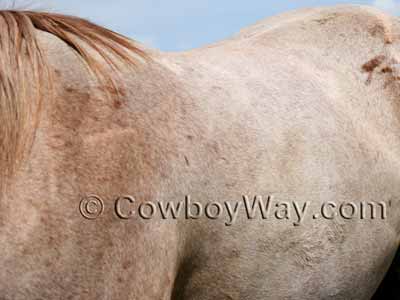
This is a close-up of a gelding that is a full brother to the mare in the photos above. He is also a red roan, but has more red hairs than white hairs, making him a darker roan than his full sister.

Skewbald
A skewbald colored horse has a spotted coat made up of white and any other color besides black. For example, a skewbald horse might be chestnut and white. The spots are large and irregular in shape.
The term skewbald is more common in European countries than in the United States. In the United States the terms "pinto" and/or "Paint" are more commonly used to describe a horse with large spots.
A skewbald.
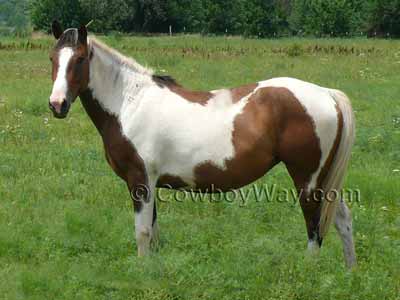
Sorrel
Sorrel horses have body colors of various shades of red. The mane and tail may be the same color as the body or flaxen (lighter).
This sorrel horse has a mane and tail the same color as its body.
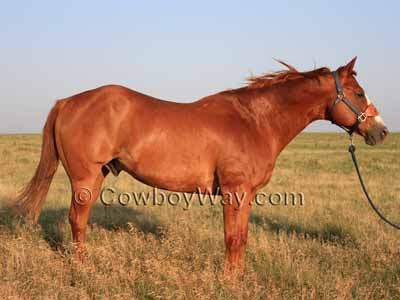
This sorrel horse has a flaxen mane and tail.

It is worth mentioning that some individuals and breed organizations do not recognize the color sorrel. Instead, they classify it as a type of chestnut. However, since the term sorrel has been used by horse people for years and is recognized by some breed organizations, we have included it here.
How To...
… Care For Your Felt Cowboy Hat
… Care For Your Saddle Pad Or Blanket
… Close A Gate With A Chain Latch
… Estimate Cattle Age By Their Teeth
… Fishtail Braid Your Horse's Tail
… Make A Bridle Rack Out Of Tin Cans
… Make A Collapsible Wood Saddle Rack
… Make A Flag Boot Out Of A Horn
… Make Homemade Hoof Conditioner
… Make Homemade Horse Fly Spray
… Measure A Western Saddle Seat
… Put A Horn Knot On Your Rope
… Put A Speed Burner On A Honda
… Recognize Common Horse Colors
… Recognize Common Horse Face Markings
… Stop A Saddle From Squeaking
… Tell A Boy Cow From A Girl Cow
… Tell A Horse Skull From A Cow Skull
… Tie A Stopper Knot
Tie a stopper knot for the end of a rope, or a metal, rawhide, or plastic honda
… Tie A Stopper Knot For A Honda
Tie a stopper knot for a tied honda
… Understand Leather / Hide Thickness
… Weigh A Horse and Optimize Rider Weight
… Wrap A Saddle Horn With Rubber
You Might Also Like...
